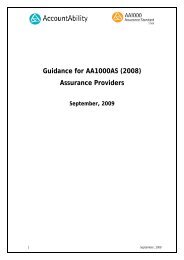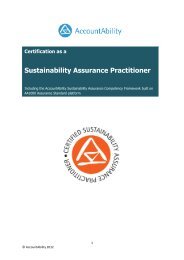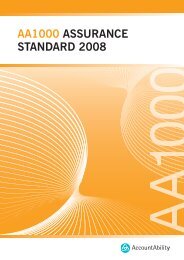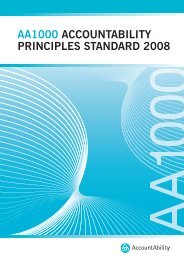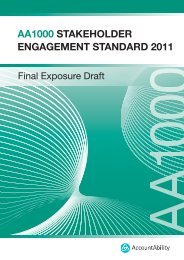The Stakeholder Engagement Manual Volume 2 - AccountAbility
The Stakeholder Engagement Manual Volume 2 - AccountAbility
The Stakeholder Engagement Manual Volume 2 - AccountAbility
Create successful ePaper yourself
Turn your PDF publications into a flip-book with our unique Google optimized e-Paper software.
12 Offi ce of Consumer Affairs “Voluntary Codes: A Guide for their Development and Use”, Canada, 1998.<br />
STAGE 4<br />
Multi-stakeholder Alliances, Partnerships,Voluntary Initiatives, Joint Projects<br />
Companies and stakeholders from public, private and voluntary sectors taking action together<br />
through collaborative ventures or mutually agreed commitments. This may be a partnership<br />
between a single company and a stakeholder organisation, or a multi-way alliance including<br />
several participants.<br />
Voluntary initiatives involving both industry and governments have increased since the early<br />
1990s in an effort to improve sustainability performance. <strong>The</strong>y often include both a variety of<br />
commitments by individual member companies to achieve environmental or social objectives<br />
that go beyond existing regulations, and which can also take the form of codes of conduct<br />
adopted at the national or international level by industrial sector associations, or agreements<br />
on performance targets between a government and a company, a group of companies or an<br />
industry sector. <strong>The</strong>se agreements can then be complimented with specifi c agreements to<br />
take mutually supportive or joint actions towards broader goals.<br />
Key things to consider<br />
Partnership initiatives designs need to take account of the costs and benefi ts for each<br />
of the participants – they may not share a common set of goals or values but they can work<br />
together to achieve specifi c shared objectives.<br />
Many partnership initiatives start in an informal manner and are initiated or catalysed<br />
by a strong individual champion within one of the organisations, who might be acting as<br />
a partnership broker to bring organisations together. In the longer term, in order to become<br />
durable and embedded within the organisations involved, partnerships need to develop a<br />
more formal structure and governance process.<br />
A partnership often grows to include more partners over time, as needed to achieve its<br />
objectives and meet the needs of stakeholders within a changing environment.<br />
As partnerships become more focused and technical, for example voluntary initiatives to<br />
develop specifi c codes, they tend to become more formalised in both process and<br />
outcome. In the late 1990s a study by the Canadian Government 12 identifi ed the<br />
following eight steps for developing effective voluntary codes: 1. Gathering information;<br />
2. Preliminary discussions with major stakeholders; 3. Create a working group;<br />
4. Preliminary draft of the code; 5. Consultations on Preliminary draft; 6. Publication and<br />
dissemination of the Code; 7. Implementation; 8. Review.<br />
THE PRACTITIONER'S HANDBOOK ON STAKEHOLDER ENGAGEMENT | 107



